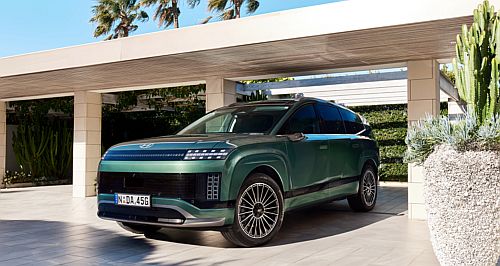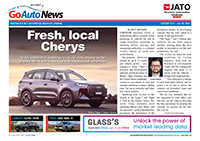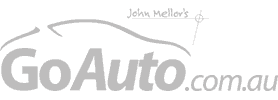Make / Model Search
News - HyundaiWithout naming names, Hyundai targets ToyotaHMCA aims squarely at market leader as CEO champions premium push over price wars4 Aug 2025 By HAITHAM RAZAGUI and MATT CAMPBELL HYUNDAI Motor Company Australia’s new CEO has identified Toyota as a key benchmark in his strategy to keep moving the South Korean brand upmarket rather than compete on price with Chinese manufacturers.
Don Romano, speaking at last week’s Ioniq 9 launch in New South Wales, made it clear that Hyundai would rather chase brand prestige than engage in a race to the bottom on pricing.
“Leave the cheap stuff to Chinese (brands) and move on,” Mr Romano declared when questioned about Hyundai's market positioning.
While not naming Toyota directly when asked about benchmarking, Mr Romano’s description left little doubt about which company Hyundai has in its sights.
“Who’s the biggest brand in Asia Pacific, maybe even locally? You don’t have to answer that question. But if that doesn’t give you an idea of where we’re headed,” he added.
“We want to be a stronger brand.”
Mr Romano – who brings 40 years of automotive industry experience to the role, most recently a successful 10-year term as president and CEO of Hyundai Auto Canada where he oversaw a period of record growth – said sustainable success comes from looking forward rather than watching emerging competitors.
“Don’t look through the rearview mirror to drive forward. Look through the windshield,” he continued.
“There’s always going to be someone that’s cheaper, that can build a car for less money somewhere, and if you look through the rearview mirror, you’re going to see them there.”
Asked why there was a need for the Ioniq 9 when Hyundai already has the Santa Fe and Palisade large SUVs plus the Staria people mover, Mr Romano outlined his vision for Hyundai to compete at the top of each segment rather than on price alone, specifically citing Toyota’s market strength and product line-up of overlapping models as the template.
“I can think of at least one company that I would look at as a benchmark and say they’ve been here longer, they’ve been doing it longer, and they do it well,” he said.
“That’s who we have to look at, not at all these newcomers behind us.”
Mr Romano was particularly emphatic about brand power and consumer perception, noting (without naming) Toyota’s advantages in reliability perception and customer loyalty.
“People say, ‘Wow, that’s a reliable vehicle. That’s a good vehicle. I want that, (it) has great loyalty’. That’s what we mean by more premium,” he explained.
However, Mr Romano was careful to clarify that moving upmarket does not mean abandoning volume segments, with models like the Venue light SUV remaining in the range alongside the recently launched Inster which serves as Hyundai’s entry-level battery electric vehicle.
The strategy comes as Hyundai enjoys strong growth momentum in Australia, with Mr Romano describing the importer as “in one of the strongest growth modes in the industry” and one that does not need to chase volume through aggressive pricing.
Of Australia’s top 10 best-selling car brands in the first half of this year, Hyundai was among just four to post an uptick with a 7.9 per cent sales increase alongside Mazda (up 0.8 per cent), GWM (up 17 per cent) and BYD (up 114.6 per cent).
Hyundai’s stated approach also reflects economic realities, with Mr Romano predicting that cost advantages currently enjoyed by Chinese manufacturers will eventually disappear – although he would not be drawn on the financial fortification of domestic car brands by Beijing and other levels of government within China beyond acknowledging media reports on the matter.
“Eventually, when you look at the same systems that are used to build these cars and the same equipment and the same materials, eventually it comes to an equilibrium where we’re all having the same cost factor,” he said.
Hyundai’s premium positioning strategy is already evident in products like the $119,750 (plus on-road costs) Ioniq 9, which Mr Romano acknowledged is more about brand building than volume sales.
“I’m not looking at it to grow market share. I’m looking at it … more as a brand opportunity for us, just to say this is what we stand for,” he said of the flagship electric SUV, which he expects to achieve only “minuscule volume”.
The Ioniq 9 also serves as the most recent of many examples of Hyundai’s willingness to take risks at the premium end of the market, with Mr Romano describing it as a “bold play” that helps establish the brand’s credentials.
“We brought one of the smallest ones out, and we’re bringing out one of the biggest. Who can offer that range?” he said, referring to the price and size span from the Inster to the Ioniq 9.
“If we don’t start moving upmarket, I think that’s the risk,” he warned.
“There’s a number of manufacturers that are not taking that type of bold step. They’re going to regret it in the future.”  Read more24th of July 2025  Hyundai shakes up its Kona SUV line-upTurbo-petrol Kona axed as new Elite grades join Hyundai’s small SUV range15th of July 2025  Three-row Hyundai Ioniq 9 priced from $120KHyundai Ioniq 9 flagship electric SUV arrives with 600km range claim, luxury features14th of July 2025  Hyundai unleashes Ioniq 6 N at Goodwood FOSKorean marque adds to its high-performance EV line-up, introducing 478kW Ioniq 6 N29th of April 2025  Hyundai takes hybrid tech to next levelSignificantly enhanced petrol-electric hybrid systems here soon from Hyundai Motor Group16th of April 2025  Hyundai Inster arrives priced from $39,000All-electric light SUV offers 360km of driving range, Hyundai Inster now available |
Click to shareHyundai articlesResearch Hyundai Motor industry news |











Facebook Twitter Instagram